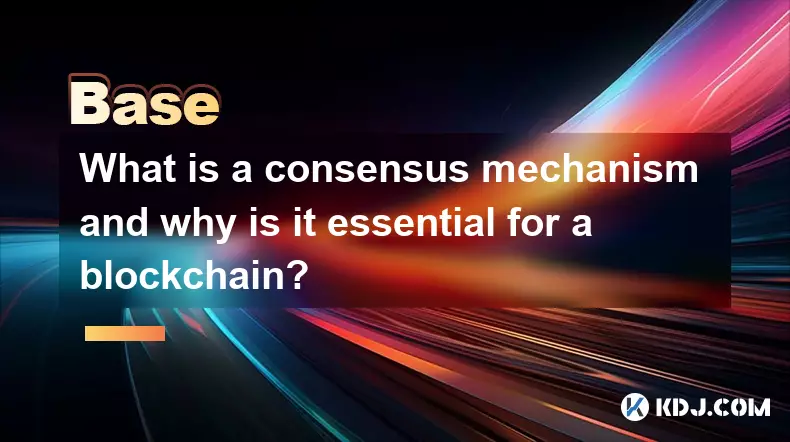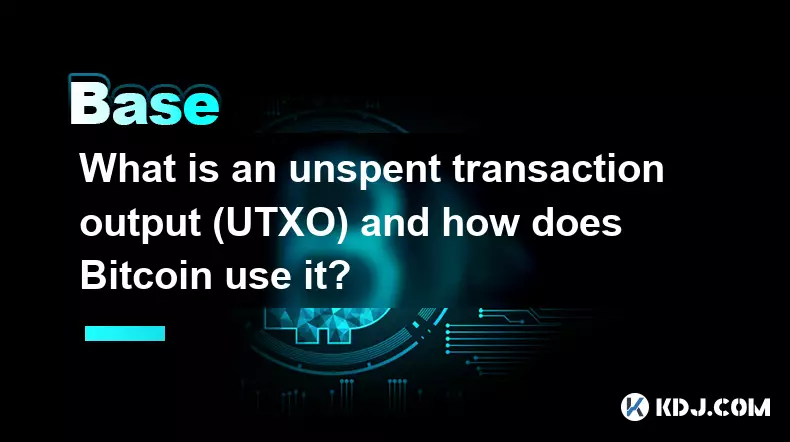-
 bitcoin
bitcoin $102182.982207 USD
-0.92% -
 ethereum
ethereum $3438.744518 USD
0.12% -
 tether
tether $0.999933 USD
0.02% -
 xrp
xrp $2.405093 USD
0.05% -
 bnb
bnb $956.306114 USD
-0.53% -
 solana
solana $153.028851 USD
-1.23% -
 usd-coin
usd-coin $0.999800 USD
-0.03% -
 tron
tron $0.294898 USD
-1.08% -
 dogecoin
dogecoin $0.171428 USD
-0.58% -
 cardano
cardano $0.551186 USD
-1.15% -
 hyperliquid
hyperliquid $38.755878 USD
0.04% -
 chainlink
chainlink $15.298460 USD
-0.05% -
 bitcoin-cash
bitcoin-cash $516.067428 USD
1.68% -
 stellar
stellar $0.280726 USD
-0.42% -
 zcash
zcash $518.919369 USD
18.01%
What is a consensus mechanism and why is it essential for a blockchain?
Consensus mechanisms ensure blockchain networks agree on transaction validity, prevent tampering, and maintain security without a central authority.
Nov 10, 2025 at 03:00 am

Understanding Consensus Mechanisms in Blockchain
1. A consensus mechanism is a protocol used by blockchain networks to achieve agreement on the state of the ledger across distributed nodes. This process ensures that all participants in the network validate transactions and blocks in a trustless environment, eliminating the need for a central authority.
2. Without consensus, conflicting versions of transaction history could exist, leading to double-spending or data inconsistency. The mechanism guarantees that only valid transactions are added and that every node updates its copy of the blockchain uniformly.
3. Different blockchains implement various types of consensus models, each with distinct rules for selecting validators and confirming blocks. These models balance security, decentralization, and efficiency based on the network’s goals.
4. The reliability of a blockchain’s operation hinges on the robustness of its consensus design. Networks must resist attacks such as 51% takeovers while maintaining performance under fluctuating participation levels.
5. In decentralized ecosystems where participants may not know or trust each other, consensus provides the foundation for coordinated action. It aligns incentives so that honest behavior yields rewards, while malicious activity incurs penalties.
Types of Common Consensus Models
1. Proof of Work (PoW) requires miners to solve complex cryptographic puzzles using computational power. Bitcoin uses this model, where the first miner to solve the puzzle adds a new block and receives a reward in BTC.
2. Proof of Stake (PoS) selects validators based on the amount of cryptocurrency they hold and are willing to 'stake' as collateral. Ethereum transitioned to PoS to reduce energy consumption and increase scalability.
3. Delegated Proof of Stake (DPoS) allows token holders to vote for delegates who secure the network. This approach increases transaction speed but can lead to higher centralization due to fewer active validators.
4. Practical Byzantine Fault Tolerance (PBFT) focuses on achieving fast consensus in systems where some nodes may fail or act maliciously. It's used in private or permissioned chains like Hyperledger Fabric.
5. Proof of Authority (PoA) relies on approved accounts with verified identities to validate transactions. It offers high throughput and is suitable for enterprise use cases where identity verification is critical.
The Role of Consensus in Network Security
1. Consensus mechanisms prevent tampering by making it economically unfeasible to alter past blocks. An attacker would need to control a majority of the network’s resources—whether computing power or staked tokens—to rewrite history.
2. By enforcing validation rules, consensus discourages dishonest behavior through slashing conditions or loss of mining rewards. Validators who attempt fraud lose their stake or investment.
3. Distributed agreement reduces single points of failure. Even if some nodes go offline or are compromised, the network continues operating securely as long as the consensus threshold is met.
4. The immutability of blockchain records stems directly from the strength of its consensus protocol. Once data is confirmed through multiple rounds of agreement, reversing it becomes practically impossible.
5. Regular finality checks ensure that transactions reach an irreversible state after a certain number of confirmations. This predictability builds confidence among users and developers relying on settlement guarantees.
Incentive Structures and Decentralization
1. Block rewards and transaction fees motivate participants to contribute resources toward securing the network. Miners in PoW and validators in PoS earn compensation for their role in maintaining consensus.
2. Economic alignment ensures that actors benefit most when they follow the rules. Attempting to manipulate the system typically results in greater financial loss than potential gain.
3. Well-designed incentive models promote long-term network health by encouraging broad participation and reducing concentration of power. When too few entities control validation, the risk of collusion or censorship rises.
4. Some protocols include dynamic adjustment mechanisms that respond to changes in network activity or validator behavior. These help maintain stability even during periods of volatility or rapid growth.
5. Token distribution strategies often accompany consensus designs to avoid early centralization. Fair launches, airdrops, and vesting schedules aim to spread influence across a diverse user base.
Frequently Asked Questions
What happens if two blocks are mined at the same time in a PoW blockchain?In Proof of Work, simultaneous block creation leads to a temporary fork. The network follows the longest chain rule, meaning subsequent miners build on whichever block they receive first. Eventually, one chain becomes longer and is accepted as canonical, while the other block becomes orphaned.
How does Proof of Stake prevent wealthy stakeholders from dominating the network?While larger stakes increase the probability of being selected to validate, most PoS systems incorporate randomization and delegation features. Additionally, penalties for misbehavior and mandatory cooldown periods for unstaking help mitigate excessive centralization of control.
Can a blockchain function without a consensus mechanism?No. Without consensus, there would be no reliable way to agree on transaction order or account balances. Every node might have a different version of the truth, rendering the system unusable for secure value transfer or smart contract execution.
Why do some blockchains switch from PoW to PoS?Blockchains migrate to Proof of Stake primarily to improve energy efficiency, enhance scalability, and reduce barriers to entry for validators. PoS eliminates the need for expensive mining hardware and allows more participants to join the network with lower resource requirements.
Disclaimer:info@kdj.com
The information provided is not trading advice. kdj.com does not assume any responsibility for any investments made based on the information provided in this article. Cryptocurrencies are highly volatile and it is highly recommended that you invest with caution after thorough research!
If you believe that the content used on this website infringes your copyright, please contact us immediately (info@kdj.com) and we will delete it promptly.
- TRX Price & Tron's Resilience: Is the $EV2 Presale the Next Big Thing?
- 2025-11-13 17:00:02
- Sui's Stablecoin USDsui: Fueling the DeFi Ecosystem and Beyond
- 2025-11-13 17:30:01
- Meme Coins in the Hype Market: Utility vs. Virality in 2025
- 2025-11-13 16:55:01
- Bitcoin ATMs: Asia Heats Up as North America Faces Scrutiny
- 2025-11-13 17:20:01
- Crypto Payroll, Regulation, and Innovation: Navigating the New Frontier
- 2025-11-13 17:20:02
- Hakimi Meme Coin, Joyoung Soymilk, and BSC ROI: A Wild Ride in Crypto!
- 2025-11-13 17:30:02
Related knowledge

What is the difference between a transparent and a shielded transaction?
Nov 10,2025 at 05:59pm
Understanding Transparent Transactions in Cryptocurrency1. Transparent transactions are the standard form of transaction on most public blockchains li...

What is a "crypto airdrop farmer" and what strategies do they use?
Nov 09,2025 at 03:39pm
What Is a Crypto Airdrop Farmer?1. A crypto airdrop farmer is an individual who actively participates in blockchain projects to qualify for free token...

What is an unspent transaction output (UTXO) and how does Bitcoin use it?
Nov 12,2025 at 01:40am
Understanding the Concept of Unspent Transaction Output (UTXO)1. An Unspent Transaction Output, commonly referred to as UTXO, is a fundamental compone...

How do you track a crypto portfolio across multiple wallets and chains?
Nov 12,2025 at 04:19pm
The Evolution of Decentralized Exchanges in the Crypto Ecosystem1. Decentralized exchanges (DEXs) have transformed how users trade digital assets by r...

How does a crypto insurance protocol work?
Nov 08,2025 at 12:39am
Understanding Crypto Insurance Protocols1. A crypto insurance protocol operates by offering financial protection against losses incurred from digital ...

What is token composability and why is it called "DeFi Legos"?
Nov 09,2025 at 06:39am
Bitcoin's Role in Decentralized Finance1. Bitcoin remains the cornerstone of decentralized finance, serving as a benchmark for value and trustlessness...

What is the difference between a transparent and a shielded transaction?
Nov 10,2025 at 05:59pm
Understanding Transparent Transactions in Cryptocurrency1. Transparent transactions are the standard form of transaction on most public blockchains li...

What is a "crypto airdrop farmer" and what strategies do they use?
Nov 09,2025 at 03:39pm
What Is a Crypto Airdrop Farmer?1. A crypto airdrop farmer is an individual who actively participates in blockchain projects to qualify for free token...

What is an unspent transaction output (UTXO) and how does Bitcoin use it?
Nov 12,2025 at 01:40am
Understanding the Concept of Unspent Transaction Output (UTXO)1. An Unspent Transaction Output, commonly referred to as UTXO, is a fundamental compone...

How do you track a crypto portfolio across multiple wallets and chains?
Nov 12,2025 at 04:19pm
The Evolution of Decentralized Exchanges in the Crypto Ecosystem1. Decentralized exchanges (DEXs) have transformed how users trade digital assets by r...

How does a crypto insurance protocol work?
Nov 08,2025 at 12:39am
Understanding Crypto Insurance Protocols1. A crypto insurance protocol operates by offering financial protection against losses incurred from digital ...

What is token composability and why is it called "DeFi Legos"?
Nov 09,2025 at 06:39am
Bitcoin's Role in Decentralized Finance1. Bitcoin remains the cornerstone of decentralized finance, serving as a benchmark for value and trustlessness...
See all articles










































































